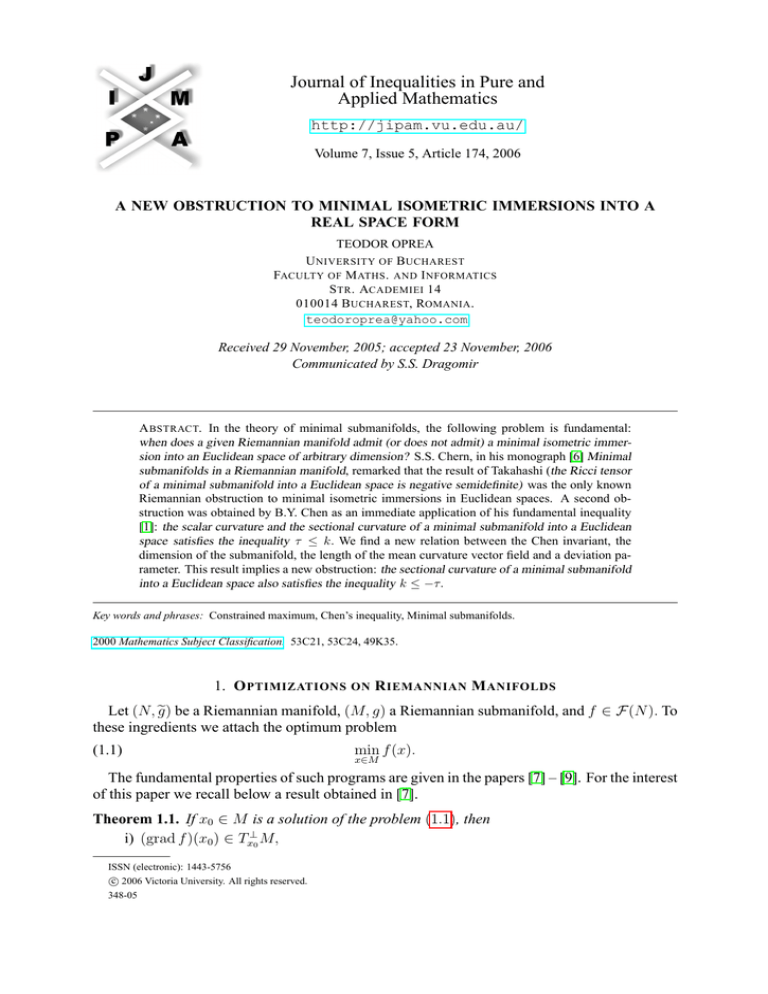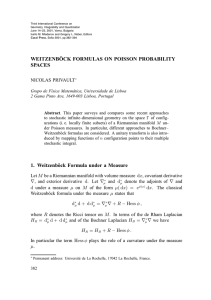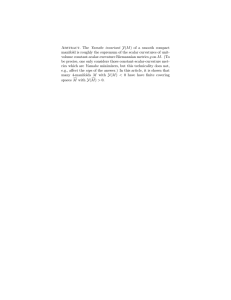
Journal of Inequalities in Pure and
Applied Mathematics
http://jipam.vu.edu.au/
Volume 7, Issue 5, Article 174, 2006
A NEW OBSTRUCTION TO MINIMAL ISOMETRIC IMMERSIONS INTO A
REAL SPACE FORM
TEODOR OPREA
U NIVERSITY OF B UCHAREST
FACULTY OF M ATHS . AND I NFORMATICS
S TR . ACADEMIEI 14
010014 B UCHAREST, ROMANIA .
teodoroprea@yahoo.com
Received 29 November, 2005; accepted 23 November, 2006
Communicated by S.S. Dragomir
A BSTRACT. In the theory of minimal submanifolds, the following problem is fundamental:
when does a given Riemannian manifold admit (or does not admit) a minimal isometric immersion into an Euclidean space of arbitrary dimension? S.S. Chern, in his monograph [6] Minimal
submanifolds in a Riemannian manifold, remarked that the result of Takahashi (the Ricci tensor
of a minimal submanifold into a Euclidean space is negative semidefinite) was the only known
Riemannian obstruction to minimal isometric immersions in Euclidean spaces. A second obstruction was obtained by B.Y. Chen as an immediate application of his fundamental inequality
[1]: the scalar curvature and the sectional curvature of a minimal submanifold into a Euclidean
space satisfies the inequality τ ≤ k. We find a new relation between the Chen invariant, the
dimension of the submanifold, the length of the mean curvature vector field and a deviation parameter. This result implies a new obstruction: the sectional curvature of a minimal submanifold
into a Euclidean space also satisfies the inequality k ≤ −τ.
Key words and phrases: Constrained maximum, Chen’s inequality, Minimal submanifolds.
2000 Mathematics Subject Classification. 53C21, 53C24, 49K35.
1. O PTIMIZATIONS ON R IEMANNIAN M ANIFOLDS
Let (N, ge) be a Riemannian manifold, (M, g) a Riemannian submanifold, and f ∈ F(N ). To
these ingredients we attach the optimum problem
(1.1)
min f (x).
x∈M
The fundamental properties of such programs are given in the papers [7] – [9]. For the interest
of this paper we recall below a result obtained in [7].
Theorem 1.1. If x0 ∈ M is a solution of the problem (1.1), then
i) (grad f )(x0 ) ∈ Tx⊥0 M,
ISSN (electronic): 1443-5756
c 2006 Victoria University. All rights reserved.
348-05
2
T EODOR O PREA
ii) the bilinear form
α : Tx0 M × Tx0 M → R,
α(X, Y ) = Hess f (X, Y ) + ge(h(X, Y ), (grad f )(x0 ))
is positive semidefinite, where h is the second fundamental form of the submanifold M
in N.
Remark 1.2. The bilinear form α is nothing else but Hess f |M (x0 ).
2. C HEN ’ S I NEQUALITY
Let (M, g) be a Riemannian manifold of dimension n, and x a point in M. We consider the
orthonormal frame {e1 , e2 , . . . , en } in Tx M.
The scalar curvature at x is defined by
X
τ=
R(ei , ej , ei , ej ).
1≤i<j≤n
We denote
δM = τ − min(k),
where k is the sectional curvature at the point x. The invariant δM is called the Chen’s invariant
of Riemannian manifold (M, g).
The Chen’s invariant was estimated as the following: “(M, g) is a Riemannian submanifold
f(c), varying with c and the length of the mean curvature vector field of
in a real space form M
f(c).”
M in M
f(c), ge) a real space form of dimension m, M ⊂ M
f(c) a Riemannian
Theorem 2.1. Consider (M
submanifold of dimension n ≥ 3. The Chen’s invariant of M satisfies
2
n−2
n
2
δM ≤
kHk + (n + 1)c ,
2
n−1
f(c). Equality is attained at
where H is the mean curvature vector field of submanifold M in M
a point x ∈ M if and only if there is an orthonormal frame {e1 , . . . , en } in Tx M and an orthonormal frame {en+1 , . . . , em } in Tx⊥ M in which the Weingarten operators take the following
form
n+1
0
0
···
0
h11
0
hn+1
0
···
0
22
n+1
0
0
h33
···
0 ,
An+1 =
.
..
..
..
..
..
.
.
.
.
n+1
0
0
0
· · · hnn
n+1
n+1
n+1
with hn+1
11 + h22 = h33 = · · · = hnn and
r
h11 hr12 0 · · ·
hr12 −hr11 0 · · ·
0
0
0 ···
Ar =
.
.
.. ..
..
..
. .
0
0
0 ···
J. Inequal. Pure and Appl. Math., 7(5) Art. 174, 2006
0
0
0
..
.
,
r ∈ n + 2, m.
0
http://jipam.vu.edu.au/
M INIMAL I SOMETRIC I MMERSIONS
3
Corollary 2.2. If the Riemannian manifold (M, g), of dimension n ≥ 3, admits a minimal
f(c), then
isometric immersion into a real space form M
k≥τ−
(n − 2)(n + 1)c
.
2
The aim of this paper is threefold:
• to formulate a new theorem regarding the relation between δM , the dimension n, the
length of the mean curvature vector field, and a deviation parameter a;
• to prove this new theorem using the technique of Riemannian programming;
2
• to obtain a new obstruction, k ≤ −τ + (n −n+2)c
, for minimal isometric immersions in
2
real space forms.
3. A N EW O BSTRUCTION T O M INIMAL I SOMETRIC I MMERSIONS I NTO A R EAL
S PACE F ORM
Let (M, g) be a Riemannian manifold of dimension n, and a a real number. We define the
following invariants
(
τ − a min k, for a ≥ 0,
a
δM
=
τ − a max k, for a < 0,
where τ is the scalar curvature, and k is the sectional curvature.
With these ingredients we obtain
a
Theorem 3.1. For any real number a ∈ [−1, 1], the invariant δM
of a Riemannian submanifold
f(c), of dimension m, verifies the inequality
(M, g), of dimension n ≥ 3, into a real space form M
a
δM
(n2 − n − 2a)c n(a + 1) − 3a − 1 n2 kHk2
≤
+
,
2
n(a + 1) − 2a
2
f(c).
where H is the mean curvature vector field of submanifold M in M
If a ∈ (−1, 1), equality is attained at the point x ∈ M if and only if there is an orthonormal
frame {e1 , . . . , en } in Tx M and an orthonormal frame {en+1 , . . . , em } in Tx⊥ M in which the
Weingarten operators take the form
r
h11 0
0 ··· 0
0 hr22 0 · · · 0
0
0 hr33 · · · 0 ,
Ar =
.
..
..
..
..
..
.
.
.
.
r
0
0
0 · · · hnn
with (a + 1)hr11 = (a + 1)hr22 = hr33 = · · · = hrnn , ∀ r ∈ n + 1, m.
Proof. Consider x ∈ M , {e1 , e2 , . . . , en } an orthonormal frame in Tx M , {en+1 , en+2 , . . . , em }
an orthonormal frame in Tx⊥ M and a ∈ (−1, 1).
From Gauss’ equation it follows
τ − ak(e1 ∧ e2 ) =
(n2 − n − 2a)c
2
m
X
+
X
(hrii hrjj
r=n+1 1≤i<j≤n
J. Inequal. Pure and Appl. Math., 7(5) Art. 174, 2006
−
(hrij )2 )
−a
m
X
(hr11 hr22 − (hr12 )2 ).
r=n+1
http://jipam.vu.edu.au/
4
T EODOR O PREA
Using the fact that a ∈ (−1, 1), we obtain
(3.1)
τ − ak(e1 ∧ e2 ) ≤
m
m
X
X
X
(n2 − n − 2a)c
+
hrii hrjj − a
hr11 hr22 .
2
r=n+1 1≤i<j≤n
r=n+1
For r ∈ n + 1, m, let us consider the quadratic form
fr : Rn → R,
X
fr (hr11 , hr22 , . . . , hrnn ) =
(hrii hrjj ) − ahr11 hr22
1≤i<j≤n
and the constrained extremum problem
subject to P :
hr11
max fr ,
+ hr22 + · · · + hrnn = k r ,
where k r is a real constant.
The first three partial derivatives of the function fr are
X
∂fr
(3.2)
=
hrjj − ahr22 ,
r
∂h11 2≤j≤n
∂fr
=
∂hr22
(3.3)
∂fr
=
∂hr33
(3.4)
X
hrjj − ahr11 ,
j∈1,n\{2}
X
hrjj .
j∈1,n\{3}
(hr11 , hr22 , . . . , hrnn )
As for a solution
of the problem in question, the vector (grad)(f1 ) being
normal at P , from (3.2) and (3.3) we obtain
n
n
X
X
r
r
r
hjj − h11 − ah22 =
hrjj − hr22 − ahr11 ,
j=1
j=1
therefore
hr11 = hr22 = br .
(3.5)
From (3.2) and (3.4), it follows
n
X
hrjj − hr11 − ahr22 =
j=1
By using (3.5) we obtain
(3.6)
hr33
n
X
hrjj − hr33 .
j=1
r
= b (a + 1). Similarly one gets
hrjj = br (a + 1),
∀j ∈ 3, n.
As hr11 + hr22 + · · · + hrnn = k r , from (3.5) and (3.6) we obtain
kr
r
(3.7)
b =
.
n(a + 1) − 2a
We fix an arbitrary point p ∈ P.
The 2-form α : Tp P × Tp P → R has the expression
α(X, Y ) = Hess fr (X, Y ) + hh0 (X, Y ), (grad fr )(p)i ,
where h0 is the second fundamental form of P in Rn and h·, ·i is the standard inner-product on
Rn .
J. Inequal. Pure and Appl. Math., 7(5) Art. 174, 2006
http://jipam.vu.edu.au/
M INIMAL I SOMETRIC I MMERSIONS
5
In the standard frame of Rn , the Hessian of fr has the matrix
0
1 − a 1 ··· 1
1−a
0
1 ··· 1
1
1
0 ··· 1
Hess fr =
.
..
.. .. ..
..
.
. . .
1
1
.
1 ··· 0
n
As P is totally geodesic in
, considering a vector X tangent to P at the arbitrary point p, that
PR
n
is, verifying the relation i=1 X i = 0, we have
X
α(X, X) = 2
X i X j − 2aX 1 X 2
1≤i<j≤n
=
=−
!2
n
X
Xi
i=1
n
X
−
n
X
(X i )2 − 2aX 1 X 2
i=1
(X i )2 − a(X 1 + X 2 )2 + a(X 1 )2 + a(X 2 )2
i=1
=−
n
X
(X i )2 − a(X 1 + X 2 )2 − (1 − a)(X 1 )2 − (1 − a)(X 2 )2 ≤ 0.
i=3
So Hess f |M is everywhere negative semidefinite, therefore the point (hr11 , hr22 , . . . , hrnn ), which
satisfies (3.5), (3.6), (3.7) is a global maximum point.
From (3.5) and (3.6), it follows
(3.8)
2
fr ≤ (br )2 + 2br (n − 2)br (a + 1) + Cn−2
(br )2 (a + 1)2 − a(br )2
(br )2 2
[n (a + 1)2 − n(a + 1)(5a + 1) + 6a2 + 2a]
2
(br )2
[n(a + 1) − 3a − 1][n(a + 1) − 2a].
=
2
By using (3.7) and (3.8), we obtain
=
(k r )2
[n(a + 1) − 3a − 1]
2[n(a + 1) − 2a]
n2 (H r )2 n(a + 1) − 3a − 1
=
·
.
2
n(a + 1) − 2a
The relations (3.1) and (3.9) imply
(3.9)
fr ≤
(n2 − n − 2a)c n(a + 1) − 3a − 1 n2 kHk2
(3.10)
τ − ak(e1 ∧ e2 ) ≤
+
·
.
2
n(a + 1) − 2a
2
In (3.10) we have equality if and only if the same thing occurs in the inequality (3.1) and, in
addition, (3.5) and (3.6) occur. Therefore
(3.11)
hrij = 0,
∀r ∈ n + 1, m, ∀i, j ∈ 1, n,
with
i 6= j
and
(3.12)
(a + 1)hr11 = (a + 1)hr22 = hr33 = · · · = hrnn , ∀r ∈ n + 1, m.
The relations (3.10), (3.11) and (3.12) imply the conclusion of the theorem.
J. Inequal. Pure and Appl. Math., 7(5) Art. 174, 2006
http://jipam.vu.edu.au/
6
T EODOR O PREA
Remark 3.2.
i) Making a to converge at 1 in the previous inequality, we obtain Chen’s Inequality. The
conditions for which we have equality are obtained in [1] and [7].
ii) For a = 0 we obtain the well-known inequality
n(n − 1)
τ≤
(kHk2 + c).
2
The equality is attained at the point x ∈ M if and only if x is a totally umbilical point.
iii) Making a converge at −1 in the previous inequality, we obtain
(n2 − n + 2)c n2 kHk2
+
.
2
2
The equality is attained at the point x ∈ M if and only if there is an orthonormal frame
{e1 , . . . , en } in Tx M and an orthonormal frame {en+1 , . . . , em } in Tx⊥ M in which the
Weingarten operators take the following form
r
h11 0 0 · · · 0
0 hr22 0 · · · 0
0
0 0 ··· 0 ,
Ar =
.
.. .. .. ..
..
. . . .
0
0 0 ··· 0
−1
δM
≤
with hr11 = hr22 , ∀ r ∈ n + 1, m.
Corollary 3.3. If the Riemannian manifold (M, g), of dimension n ≥ 3, admits a minimal
f(c), then
isometric immersion into a real space form M
(n − 2)(n + 1)c
(n2 − n + 2)c
≤ k ≤ −τ +
.
2
2
Corollary 3.4. If the Riemannian manifold (M, g), of dimension n ≥ 3, admits a minimal
isometric immersion into a Euclidean space, then
τ−
τ ≤ k ≤ −τ.
R EFERENCES
[1] B.Y. CHEN, Some pinching classification theorems for minimal submanifolds, Arch. Math., 60
(1993), 568–578.
[2] B.Y. CHEN, A Riemannian invariant for submanifolds in space forms and its applications, Geom.
Topology of Submanifolds, World Scientific, Leuven, Brussel VI (1993), 58–81.
[3] B.Y. CHEN, A Riemannian invariant and its applications to submanifolds theory, Results in Mathematics, 27 (1995), 17–26.
[4] B.Y. CHEN, Mean curvature and shape operator of isometric immersions in real-space-forms, Glasgow Math. J., 38 (1996), 87–97.
[5] B.Y. CHEN, Some new obstructions to minimal Lagrangian isometric immersions, Japan. J. Math.,
26 (2000), 105–127.
[6] S.S. CHERN, Minimal Submanifolds in a Riemannian Manifold, Univ. of Kansas, Lawrence,
Kansas, 1968.
[7] T. OPREA, Optimizations on Riemannian submanifolds, An. Univ. Buc., LIV(1) (2005), 127–136.
[8] C. UDRIŞTE, Convex functions and optimization methods on Riemannian manifolds, Mathematics
its Applications, 297, Kluwer Academic Publishers Group, Dordrecht, 1994.
J. Inequal. Pure and Appl. Math., 7(5) Art. 174, 2006
http://jipam.vu.edu.au/
M INIMAL I SOMETRIC I MMERSIONS
7
[9] C. UDRIŞTE, O. DOGARU AND I ŢEVY, Extrema with nonholonomic constraints, Geometry,
Balkan Press, Bucharest, 2002.
J. Inequal. Pure and Appl. Math., 7(5) Art. 174, 2006
http://jipam.vu.edu.au/



